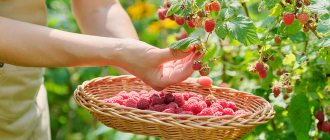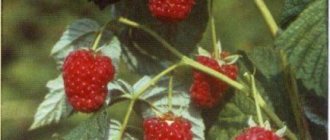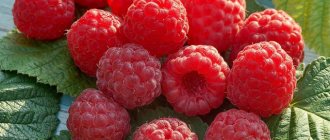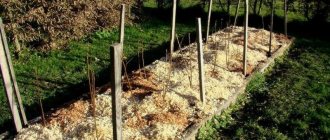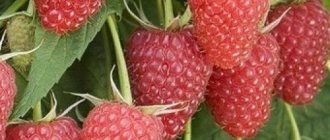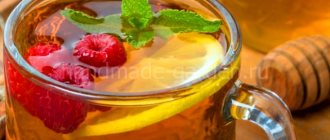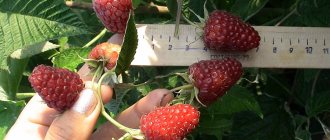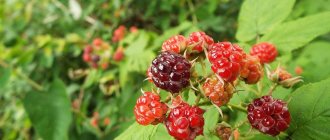Briefly about the origin
The discoverer of remontant raspberry varieties in Ukraine, V. I. Dmitriev, began breeding work in 1993, crossing Polish varieties, in particular, Porana Rosa (Morning Dew), with the raspberries of I. V. Kazakov.
V. I. Dmitriev
As a result, 15 years later, in 2008, the Brusvyana variety passed all the necessary tests and was registered in the State Register of Ukraine.
The breeding nursery of the same name “Brusvyana”, the only center of remontant raspberry varieties in Ukraine, also supplies its seedlings to Russia, Belarus, and Poland.
Nursery assortment in original presentation
Description of the raspberry variety Brusvyana
The appearance of Brusvyan's raspberries is impressive. The bush is powerful, with thick stems at the base, up to 1.5 cm in diameter, up to 2–2.5 meters high.
The Brusvyana bush looks more like a tree
The cone-shaped red berry is dense and at the same time quite juicy, with a real raspberry taste and aroma. The foliage is rich green in color, large, light brown thorns are present, but their size is moderate. Descriptions of the variety often provide information that the berry weight is 15 g, and up to 8 kg of berries can be collected from a bush. The authors of the variety claim more modest figures: 10–12 g berry weight and 2.2–2.5 kg yield per bush, which is what you should focus on.
Berry size
The surface of the berries is matte, slightly whitish, which partly spoils the presentation. Fruit branches on the stem begin to form at a height of 0.3–0.7 meters from the ground surface. In relation to the conditions of Ukraine, breeders set themselves the task of achieving heat resistance of the variety, and they succeeded: in the summer heat the berries do not bake and planting does not reduce the yield. Surprisingly, this southern variety turned out to be quite frost-resistant; it is not afraid of returning spring frosts and can continue to delight with its berries after the first short frosts in the fall.
First snow with slight frost Brusvyane doesn’t care
When grown in a one-year cycle, the harvest period lasts from the first half of August to October, it all depends on the date of onset of persistent cold weather. There are no problems with the reproduction of this raspberry, the root shoots are present, and it produces up to 5 replacement shoots in the first year or two and 6–8 in the future.
Brusvyana bushes in a two-year fruiting cycle - video
Advantages and disadvantages of the variety - table
| Advantages of the variety | Its disadvantages |
| High yield | Requirement for watering |
| The berry is tasty and aromatic | Insufficient frost resistance for the central regions of Russia when grown in a two-year cycle |
| Good transportability and keeping quality | The occasional whitishness of the berries impairs the presentation |
| High heat tolerance | |
| Sufficient frost resistance for southern regions | |
| Good shoot-forming ability | |
| Decorative appearance of bushes |
Reviews
The disadvantage of the variety is that it does not bear fruit along the entire length of the shoot, but sometimes grows up to 2.5 meters. A significant advantage over many other varieties is their unpretentiousness and cultivation without garter. In addition, the bush can be formed by pinching the shoot at the desired height, and then the side branches grow and bear fruit, like on a small tree. I form several at once in height. From a meter and above. Other varieties can also be shaped this way, but they will not support the entire mass, but Brusvyana grows without problems. Only if you pinch the top, you should leave no more than two shoots in the bush, as there will be hashish.
Volkov
https://forum.vinograd.info/showpost.php?p=1196885&postcount=131
Planting remontant Brusvyana raspberries, features
Landing location
Due to the high heat resistance of Brusvyana, there is no headache about shading it in the southern regions, and the sunnier place you give it, the better. Raspberries do not like drafts, this must be taken into account. Groundwater passing closer than 0.8 meters to the surface of the earth can provoke diseases of the root system. Based on these conditions, a place for raspberries on the site is selected; if it is located near the fence of the northern side of your land, then you can’t imagine anything better. You just need to ensure a distance of at least 1 meter from the fence; Brusvyana’s shoots are spreading.
It’s beautiful, but this won’t work with Brusvyana: placing spreading shoots close to the fence will lead to fungal diseases
The soil
In terms of demands on the composition of the soil, Brusnyana does not stand out in any way: it prefers light, loose, with a high content of humus. Therefore, for clay soil, preliminary preparation is required: 2–4 buckets per square meter are scattered on the surface. meter of humus (compost) and sand, and then the earth is dug up at least to the bayonet of a shovel. If the soil is acidic, then deoxidizing agents are added during digging: dolomite flour, lime or wood ash at approximately 0.5 kg/m2.
The easiest way to roughly estimate the acidity of the soil: a lump of earth is sprinkled with water to form a liquid slurry and sprinkled with ordinary baking soda. If the soil is acidic, bubbling will occur.
When digging, be sure to select the roots of perennial weeds - there is no need for extra competitors for food for remontant raspberries. It is advisable to carry out such soil preparation in advance, a season before the intended planting. In this case, you can also sow the area with green manure after digging and embed their green mass into the ground once or twice. The consequence of this will be an improvement in the structure of the soil and its enrichment with nitrogen.
You can plant green manure before winter
Landing dates
The optimal time for planting remontant raspberries is from mid-September to the second ten days of October. It is not worth planting later; the root system may not have time to take root before frost. In this case, it is better to bury the purchased seedlings for the winter and plant them in early spring, as soon as the snow melts.
In winter, most of the seedling should be underground
Seedlings with a closed root system are planted throughout the season.
Selection of seedlings
It sounds trivial, but the key to a successful purchase of Brusvyana seedlings is a competent choice of the seller. The most reliable way is to contact the Brusvyana nursery and find out about their partners in Russia or order seedlings directly from the nursery; with modern communications this is not a problem.
Assessment of the appearance of seedlings
- Pay attention to the degree of protection of the root system of the proposed seedling. The roots should be placed in a bag or bag and kept in a moist environment. The suction roots are very delicate and dry quickly in the air.
- With the seller's consent, remove the seedling from the bag for a minute and evaluate the condition of the roots. They should be branched, with a large number of fibrous roots.
- The stem of the seedling should be comparable in diameter to a pencil, and the length, depending on the method of obtaining it, ranges from 20 cm and above.
Branched root system of seedlings
Step by step planting process
- A hole 40 cm deep and 30 cm in diameter or a trench of the required size is dug.
- Taking into account the large branching of the variety’s shoots, we maintain a distance between seedlings of 0.7–1 m, and between rows of raspberries 1.5–2 meters.
- 1-2 buckets of humus or compost and 4-5 tablespoons of Kemira-Universal, about half of the selected soil are poured into the planting hole and all this is mixed.
- A mound is formed in the hole of such a height that after planting the seedling, its root collar is located at ground level.
- The damaged roots of the seedling are cut off, it is placed on a mound and covered with earth with light compaction, while the position of the root collar is controlled.
- The seedling is watered with 5–10 liters of water, and the ground around it is mulched with humus, compost or peat with a layer of 5 cm.
- When planting in autumn, we prune the seedling to ground level after about a month. When planting in spring, pruning is not carried out.
Rational placement of Brusvyana seedlings during planting
Growing rules
The first thing a farmer must decide for himself is on what principle he will grow Brusvyana raspberries. This raspberry variety, like other remontant species, can be grown as biannual crops or as single harvest plants.
In areas with temperate and warm climates, remontant raspberries manage to produce two full harvests per season. The first wave of fruiting begins in June, the second time the harvest begins to ripen in early August and Brusvyana manages to fully ripen before the onset of autumn frosts.
Read also: Indeterminate varieties of tomatoes for open ground
Considering all that has been said, it can be argued that it is recommended that residents of the central and southern regions of Russia take advantage of the repairability of Brusvyana. For those who live in colder climates, experts advise harvesting the entire crop at one time.
Proper landing
In order for the raspberries to turn out like in the photo from the article, and for their taste to be unforgettable, it is necessary to follow the rules of planting and caring for the remontant variety. The most important thing is to choose a suitable area in the garden for Brusvyana raspberries. This culture loves the sun, loose, nutritious soil with good drainage and reliable protection from the wind.
You can plant remontant raspberries either in spring or autumn: in April or October. Before planting, prepare holes for seedlings. A good handful of fertilizer is poured into each hole, then the raspberry harvest will be better and tastier.
Good planting Brusvyana seedlings should have a length of 15 to 20 cm, strong roots without signs of rot or damage. Thickened planting is not suitable for this tall raspberry, so the holes are made at a considerable distance from each other. The optimal planting pattern is 1x1.5-2 meters. If possible, it is better to increase the row spacing; this will make harvesting and maintenance of the raspberry tree easier.
Caring for raspberries
Proper planting and care are the key to a good harvest and high quality berries. In principle, Brusvyana does not require special attention - this raspberry is grown in the same way as other remontant varieties.
During the warm season, the gardener must do the following:
- Despite the great thickness of the shoots and their power, Brusvyana raspberry bushes can be tangled by the wind; due to a storm or heavy rain, branches with berries risk breaking off or ending up on the ground. Therefore, Brusvyana needs support in the form of supports or trellises. Each shoot of the bush should be secured with wire or rope, making an interval of 15-20 cm.
- Already in the first year of planting, raspberries produce 2-4 shoots; subsequently, the number of young shoots increases to 6-8. Therefore, there will be no problems with the reproduction of Brusvyan raspberries. In continental climates it is better to plant raspberries in the spring; in more southern regions this is done in the autumn. Bushes can also reproduce by dividing the uterine root. Any seedlings take root well and quickly, as they have a powerful root system.
- It is not recommended to pinch the shoots of remontant raspberries. This, of course, will increase the number of laterals and the total number of berries, but may affect the quality of the fruit and their size. In addition, due to the formation of the bush, the fruiting period will shift - by 10-14 days, which may turn out to be critical (the raspberries will not have time to ripen before frost).
- Brusvyana is pruned at the root in the fall. If the variety is grown in a two-year cycle, then with the onset of cold weather, the tops of the shoots that bear fruit in the current year are simply cut off.
- Raspberries should be fed in the fall, immediately after sanitary pruning or complete cutting of shoots. To do this, you can use both organic and mineral complexes. In spring, it is better to fertilize the area only with minerals.
- In the northern regions, it is recommended to thoroughly mulch the soil around the bushes with peat, sawdust or dry leaves - this will save the roots from freezing.
- During the summer, it is necessary to regularly water the raspberry tree, but you should remember the risk of rotting of the Brusvyana roots. It is better to use drip irrigation systems, turning them on for a couple of hours a day.
As you can see, the variety in question will not require special attention from the summer resident, but will reward you with a generous harvest.
Raspberry care
Trimming, pinching
Brusvyana raspberries produce the optimal number of replacement shoots in the spring, 6–8 pieces. Of these, you need to leave the 5 strongest branches, cut out the rest. If the task is not to propagate the variety, then during the growing season all emerging root shoots are cut out. In this case, nutrients will be directed only to fruiting branches.
The nature of autumn pruning of raspberries will depend on the method of its cultivation.
Two ways to grow remontant raspberries
A two-year method, similar to caring for classic raspberry varieties, involves cutting out only the shoots of the second year of life that bear fruit before winter. In this cycle, you can try to grow raspberries only in the southern regions of the country with relatively warm winters.
Despite the good winter hardiness of the variety, frosts in the middle zone can be critical for the shoots. In Brusvyana they are strong and thick, it will be problematic to bend them to the ground for wintering. The experience of cultivating Brusvyana in the south without bending down shoots shows that even there there may be isolated cases of freezing, therefore, for example, in the Central region of Russia, freezing of unprotected shoots will be ensured.
Based on this, the main method is to grow Brusvyana in an annual cycle with cutting out fruit-bearing shoots in the fall. These shoots are burned. The cut is made as close to the ground as possible.
It has been proven many times that the final raspberry yield when growing berries only on annual shoots is higher, and the raspberries themselves grow larger and tastier.
Pinching the tops of Brusvyana shoots hardly makes sense - they already have enough lateral branches. Perhaps only in order to normalize the height of the bush and for the convenience of using trellises.
Mulching and covering
After the autumn pruning of the shoots, the soil surface must be mulched with humus, compost or peat with a layer of up to 10 cm. The mulch, together with the snow cover, will serve as protection against freezing, and in early spring, as the snow melts, the first fertilizing will be delivered to the roots.
After the snow melts, it is useful to cover the planting site with light agrofibre with a density of 19–23 g/m2. It will create comfortable conditions for the rapid development of raspberries and protect emerging tender shoots from possible spring frosts. When the shoots grow to 5–7 cm, the shelter is removed. This must be done in cloudy weather.
Raspberries mulched in the fall will grow well in the spring
Feeding
Growing remontant raspberries according to the “plant and forget” principle, as many do with ordinary ones, will not work with Brusvyana. The declared yield indicators can only be achieved with increased nutrition of raspberries, because in one season its shoots go through a development cycle, which usually takes two years.
The first three seasons after planting, Brusvyana needs to be fed three times:
- Ammonium nitrate (1 tbsp/m2) after snow melts.
- A solution of ammonium nitrate and ash (3 tablespoons of nitrate and a glass of ash in a bucket of water) at the beginning of flowering and when setting berries. Consumption is one bucket/m2.
From the fourth year, fertilizing with complex mineral fertilizers is added in the second half of summer according to the standards specified in the selected form.
Fertilizing must be combined with watering and done only in cloudy weather!
Watering, loosening and weeding
Brusvyana requires regular watering, in the absence of rain at least once a week. A bucket per bush is enough; swamps should not be created under the raspberry tree; excess moisture can lead to the death of the roots. In September, after the last wave of the raspberry harvest has been harvested, the so-called moisture-charging watering before winter is necessary, again with an eye on precipitation.
The day after watering, choose a time to lightly loosen the soil while cutting back weeds, which should be left under the bushes as mulch. If you do this regularly, the process will not take much time, and the raspberries will thank you with an additional harvest.
Clean and loose soil under raspberries is the key to a good harvest.
Garter for trellises
Although Brusvyana shoots are thick and moderately rigid, many gardeners still use trellises. The bushes are tall and branched; tying them to the trellis wire makes it easier to care for raspberries and pick berries. The design of trellises can be very diverse. You just need to pay attention to the depth of the pillars into the ground: at least 70 cm, the space in the ground near the pillar must be filled with broken bricks, small stones, etc. The optimal diameter of the wire stretched between the trellises is 4 mm. To tie up shoots, two levels of wire are usually installed.
Two-tier raspberry garter
Berry picking
Brusvyana raspberry is a rather delicate crop. The berries need to be picked in dry, sunny weather. The harvest is collected immediately into a container intended for further storage or transportation. At the initial stage, fruits are collected every 1-2 days, and after two weeks from the first harvest, harvesting can be done every 3-4 days, since by this time the fruits begin to ripen unevenly.
Remontant raspberry Brusvyana has been gaining popularity in recent years. Its easy-going nature and high yields attract gardeners. Simple but regular care will allow you to grow a strong plant and harvest a bountiful harvest of aromatic berries.
Diseases and pests of the variety
Brusvyana is not prone to any disease to a greater extent, as happens with some varieties of remontant raspberries. In such cases they write: disease resistance at the level of standard varieties. This is a big plus for Brusvyana. Let us describe several of the most common lesions.
Diseases of the variety, table
| Disease | Manifestation of the disease | Prevention | Control measures |
| Anthracnose | Grayish spots with bright borders form on the foliage and shoots. Leaves may dry out. The tops of shoots and fruit branches wither | Use healthy seedlings when planting. Spraying with a 1% solution of Bordeaux mixture in the spring when the shoot size reaches approximately 0.3–0.5 m. Do not allow the plantings to thicken. Planting marigolds, calendula, nasturtium, and mustard near the raspberry tree | Cutting out diseased shoots, removing diseased berries and burning them. The use of drugs Topsin-M, Fundazol, Nitrafen, as well as colloidal sulfur before setting berries |
| Gray rot | A gray fluffy coating of spores and mycelium of the fungus forms on the berries. Cool and wet weather contributes to the spread of the disease. | ||
| White or purple spotting | Brownish, white or purple spots with a dark border appear on the leaves and stems of raspberries. The stem is often affected at the attachment points of the leaves. Over time the foliage fades | ||
| Rust | First, fungal spore pads appear on the upper and then on the lower sides of the leaves. Their color can be yellow, orange, purple |
Diseases of the variety: examples in the photo
Spots on leaves and shoots due to anthracnose
Such berries can be found in cold rainy summers
Damage to leaves due to disease
Severe damage to stems, leaves wither
Yellow leaf pads due to rust
If you grow Brusvyana in an annual cycle, then you can forget about the main pest of raspberries - the raspberry beetle; by the time the berries form, it curtails its activity. Consider the fight against ticks and raspberry flies.
Pest varieties, table
| Pest | Description of the pest | Manifestation of his activities | Prevention | Control measures |
| Raspberry mite | A small arachnid parasite that lives on the undersides of leaves | The leaves become covered with greenish oily spots and become deformed. The pest usually appears in cold, rainy summers | Watering the raspberry tree in early spring with hot water, purchasing healthy planting material. Destroying weeds, loosening the soil | Use of colloidal sulfur, drugs Akarin, Agrovertin, Fitoverm, Bitoxibacillin before raspberry flowering. Folk remedies include spraying with infusion of chopped onions (20–30 g/liter of water, infused for 8 hours) or infusion of garlic (1–2 cloves per liter of water, infused for 5 days in a dark place). Strain the infusions before use |
| Spider mite | A very small parasite. Size no more than 0.6 mm | The mite forms a thin web on the leaves and sucks the juices from them. The leaves curl. Dry and hot summers contribute to the spread of the pest. | ||
| Raspberry stem fly | The size of the fly is about 5 mm, the color is gray. Departure from the ground - at the end of May | The fly larva penetrates the core of the shoot, it droops and, if the affected part is not cut off, dies | Shallow loosening of the soil in the fall so that the fly pupae are on the surface. Spraying with a baking soda solution (2 tablespoons/10 liters of water) during berry set | Timely cutting off the affected part of the shoots. Using Actellik before raspberry blossoms |
Pest varieties, photo gallery
The color of the parasite may vary
Yellow-green spots on deformed leaves
Tick under high magnification
Leaves are webbed and twisted
Its size is only 5 mm
The work of the raspberry fly larva
All drugs listed in the tables are used in accordance with their instructions!
Bushes
Raspberries are represented by strong plants. Their shoots are not prone to lodging. An important feature is the strong density of the inflorescences. But even after the abundance of the harvest has ripened, the stems do not bend under the weight of many berries. The height of the plants is about 2 m. But sometimes they can reach a more impressive size. Harvesting is facilitated by the genetic feature of the variety - the bare upper parts of the shoots (without thorns).
Note: Although “Brusvyana” is a tree-like raspberry, it is better to install supports that will facilitate further care of the berry plantings.
Harvest and use
From mid-August, when the fruiting of ordinary raspberries has already ended, Brusvyana comes into its own. The old Russian word brusvyany has synonyms crimson and red, and these colors are the best match for this raspberry.
By the way, the name of the well-known lingonberry comes from the same word.
Bar berries
It has already been said about the yield of the variety; it is most likely impossible to collect less than 2 kg from a bush, but what is above is care, soil and weather conditions. You shouldn’t leave ripe raspberries on the bush for a long time - the sooner they end up in the basket, the sooner the ripening berries will begin to pour in; there should be a continuous conveyor. Transporting raspberries from the dacha to home is not a problem; the dense Brusvyana berry tolerates transportation well.
It will keep quietly in the refrigerator for a week, but how can you prepare it for the winter? There is a wide choice: jam, pureed with sugar - “live raspberries”, dried, frozen, for liqueurs and pies. And the main use of berries from the bush and directly into the mouth, the sweet and sour aromatic Brusvyana on a sunny September day cannot but be liked.
Description and characteristics
The culture belongs to the remontant varieties. It is capable of producing 2 crops during the season. First, the fruits appear on two-year-old shoots, then on the stems of the current year. The bushes are large in size and can reach 2 m. Replacement shoots are actively formed on the plants, which makes the bushes very dense.
The description of the Brusvyan raspberry says that it has straight light brown stems and green thorns. The embossed leaves of the plant have a rich green tint.
A lot of raspberries are formed on the fruit branches. The elongated berries have a glossy surface and a rich crimson color. They boast large sizes and weigh 6-10 g. The pulp has a dense consistency and a pronounced raspberry aroma.
The fruit is characterized by a sweet and sour taste. They have many useful properties. This is due to the high content of vitamins and minerals.
This is interesting! Raspberry leaves can also be used for therapeutic purposes - they are added to teas and cosmetics.
The berries of this variety are characterized by large sizes.
